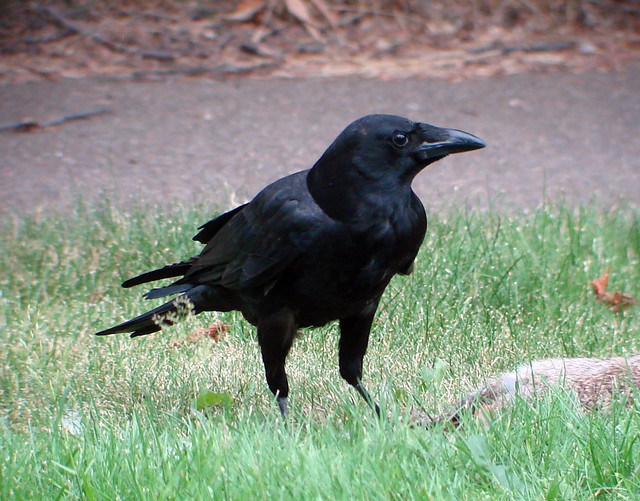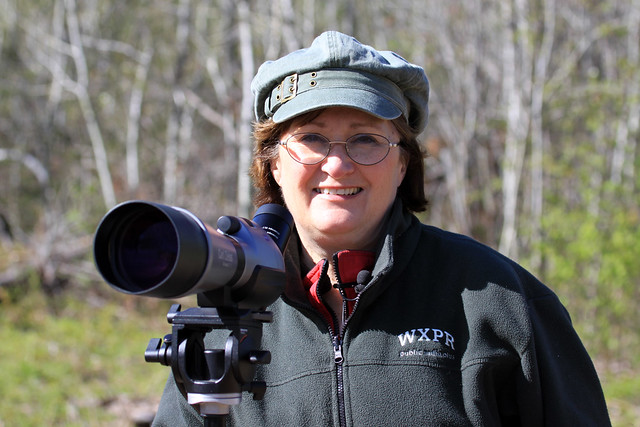 An American crow is shown here eating the remains of a rabbit killed by a car. Crows and humans have a lot in common, including strong family ties and, according to a Cornell University researcher, even a love of junk food. Photo courtesy of Laura Erickson
An American crow is shown here eating the remains of a rabbit killed by a car. Crows and humans have a lot in common, including strong family ties and, according to a Cornell University researcher, even a love of junk food. Photo courtesy of Laura Erickson
We first saw Hurt Crow — that’s what we named him, even though we weren’t sure if he was a crow or a raven — early in the summer. He was hobbling around in our front yard. His left wing was dragging in the grass alongside him.
My first instinct was to try to rescue him. I called for my son, and he and I walked toward the injured animal without thinking a great deal about what we’d actually do if we got near him.
We didn’t have to worry too much about that.
Hurt Crow was not interested in being rescued. And, I would later learn, that was probably a good thing for Hurt Crow.
A half hour later, my son, his friend and I had scrambled all around the neighborhood trying to get close to him. At one point we had him trapped from three directions under a neighbor’s deck. I’m not sure how he got away from us. But he did.
He even eluded the volunteers from Wildwoods Rehabilitation Center when they came over later in the day.
We saw him a few times over the summer. He still seemed to be injured, though it looked as though his wing wasn’t hanging down quite as low as it used to. On a couple of occasions I walked toward him and found that he could get just airborne enough to be halfway across the yard within a second or two. He also learned how to hop up into trees from branch to branch as a way of eluding me and, I suppose, potential predators.
With winter coming on quickly, I’ve started to look around the neighborhood for Hurt Crow, but I haven’t been able to find him.
 Duluth resident Laura Erickson has been doing a weekly radio program called For the Birds on KUMD radio since 1986. You can download recent podcasts of that show. Photo courtesy of Laura Erickson
Duluth resident Laura Erickson has been doing a weekly radio program called For the Birds on KUMD radio since 1986. You can download recent podcasts of that show. Photo courtesy of Laura Erickson
Duluth birding expert Laura Erickson told me that Hurt Crow probably was a crow and not a raven, though they are very hard to tell apart. Ravens, she said, “are gynormous” and, if it had been an injured raven, it would most likely have been attacked by neighborhood crows. But crows don’t hurt fellow crows — unless they are strangers.
“If he has food and friends, he has a pretty good chance of making it through,” she said.
Erickson said that because Hurt Crow had plenty of company every time I saw him, it’s a good indicator he may have a chance of surviving the winter. Crows, she said, are some of the most human-like of birds.
Crows will often spend their lives in the nesting area where they were born, though they may venture afield in the winter months in search of food. What’s more, crows often stay with their family and extended family in groups of 15 or more: children, brothers, sisters, and even adopted orphans.
Erickson told me that Cornell University researcher Kevin McGowan has documented cases of crows caring for other crows when injured. In some cases, crows will care for family members for long periods of time, even if the animal is permanently disabled.
If I had managed to capture Hurt Crow, she said, it might not have been for the best.
Crows, she explained, don’t trust humans, and being in captivity for a crow is torture. Erickson said she takes all this into consideration when deciding whether to attempt to rescue an animal.
“When I intervene,” Erickson said, “what I have to do is weigh the stress that the bird goes through in order for me to get it and what stress it will go through in the rehab versus the probable outcome.”
If I was right and Hurt Crow’s wing was broken, then it’s virtually impossible to repair. And since a crow is considered a game animal in Minnesota, it probably would have been euthanized rather than saved.
Instead of condemning an animal to die in captivity, Erickson said, she tries to make sure the animal at least has access to food. So, that, even if the animal dies in its sleep or is taken by a hawk, “at least they don’t die hungry and maybe even have a nice meal,” she said. She said crows seem fond of peanut butter sandwiches.
On a recent morning walk with my dog, I came around a street corner in the neighborhood to find a crow resting in the grass just by the sidewalk.
The crow wasn’t standing on its legs. It was sitting on the grass almost as if it were sitting in a nest, with its legs tucked under its body. I’d never noticed a crow resting on the ground like this before.
I walked closer and the bird didn’t move. Hurt Crow? I wondered.
I came even closer, but didn’t want to get too close as my dog was with me.
Finally, when I was about 10 feet away, the bird rose up on its legs and flapped off to a branch on a nearby tree.
If it was Hurt Crow, I may need to consider changing his name.
Clarification: This story has been updated from an earlier version that said crows will not attack fellow crows. In fact, Laura Erickson said, crows will attack other crows if they are strangers. They will not attack crows that are in their family line or ones that are residents of their neighboring community. "They are xenophobic," Erickson said.
